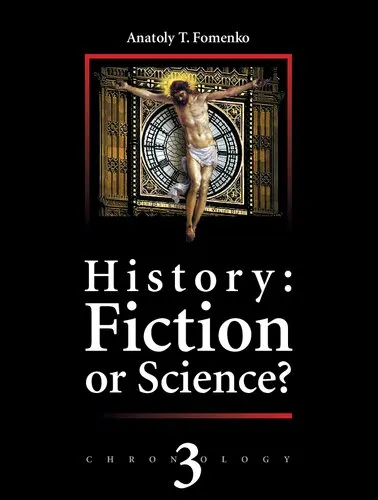History Fiction Or Science Vol. 3; Astronomical methods applied to chronology. Ptolemy`s Almagest. Tycho Brahe. Copernicus. The Egyptian zodiacs.
3.5
بر اساس نظر کاربران

شما میتونید سوالاتتون در باره کتاب رو از هوش مصنوعیش بعد از ورود بپرسید
هر دانلود یا پرسش از هوش مصنوعی 2 امتیاز لازم دارد، برای بدست آوردن امتیاز رایگان، به صفحه ی راهنمای امتیازات سر بزنید و یک سری کار ارزشمند انجام بدینمعرفی کتاب "History Fiction Or Science Vol. 3; Astronomical methods applied to chronology. Ptolemy's Almagest. Tycho Brahe. Copernicus. The Egyptian zodiacs."
کتاب "تاریخ: افسانه یا علم؟ جلد سوم" اثری برجسته از آناتولی فومنکو است که در آن نویسنده به بررسی روشهای نجومی برای بازنگری در تاریخشناسی سنتی میپردازد. این کتاب با استفاده از دانش نجومی، دادههای تاریخی را تحلیل کرده و به تفاسیر جدیدی در خصوص آثار معروفی نظیر Almagest از بطلمیوس و نظریات Tycho Brahe و Copernicus میرسد. یکی از برجستهترین بخشهای این اثر، تحلیل دقیق زودیاکهای مصری است که قدمتی بالغ بر هزاران سال دارند و به صورت خاص با تکنیکهای پیشرفته بررسی میشوند.
فومنکو در این اثر، علم نجوم را به عنوان ابزاری قدرتمند در بازبینی تاریخ معرفی میکند و تلاش دارد نشان دهد که چگونه تقویمهای کهن میتوانند حاوی دادههای اشتباهی باشند که به مرور زمان به باور عمومی تبدیل شدهاند.
خلاصهای از کتاب
این کتاب در چهار بخش اصلی تنظیم شده است. بخش اول به نقد و بررسی Almagest اثر بطلمیوس اختصاص دارد و در آن نویسنده به تحلیلهای نجومی که توسط بطلمیوس ارائه شده میپردازد. فومنکو بیان میکند که بخشهایی از دادههای این کتاب ممکن است در تناقض با واقعیات نجومی باشد و تاریخ نگارش آن را به چالش میکشد.
در بخش دوم، آثار Tycho Brahe و Copernicus بررسی میشوند. نویسنده به تحلیلهای ساختاری این دو دانشمند میپردازد و همچنین دادههایی را از نظر زمانی و کیهانی بررسی میکند تا نشان دهد چگونه این تحلیلها درک ما از تاریخ و دورههای نجومی را تغییر دادهاند.
بخش سوم به زودیاکهای مصری اختصاص دارد و در این بخش، نویسنده با استفاده از روشهایی مدرن به تاریخ دقیق این نقوش و کاربرد نجومی آنها میپردازد. فومنکو معتقد است که این زودیاکها نه تنها نشاندهنده وضعیت ستارگان هستند، بلکه میتوانند ابزار دقیقی برای تاریخگذاری آثار باستانی باشند.
در نهایت، بخش چهارم به جمعبندی یافتهها و ارائه نتایج کلی میپردازد. فومنکو در این بخش استدلال میکند که استفاده از روشهای نجومی میتواند راهی نوین برای بازنگری در تاریخچه و نقشه زمانی بشر ارائه دهد.
نکات کلیدی کتاب
- تحلیل روشهای نجومی برای بازنگری در تاریخ؛
- بررسی تناقضهای تاریخی در آثار بطلمیوس؛
- شناخت دقیق زودیاکهای مصری و کاربرد تاریخی آنها؛
- بررسی تاثیر Tycho Brahe و Copernicus بر تاریخ نجوم؛
- ارائه دیدگاهی خلاقانه برای بازنویسی تاریخ بشر.
جملات معروف از کتاب
"The methods of modern astronomy can and should rewrite the outdated chronological frameworks imposed on historical data."
"The Egyptian zodiacs are not mere decorations; they are databases encrypted in stars."
"By questioning Ptolemaic data, we question the very foundation of what we consider historical truths."
اهمیت این کتاب
کتاب "History Fiction Or Science Vol. 3" اثری است که اهمیت آن فراتر از تاریخنگاری سنتی است زیرا پرسشهای بنیادینی را در مورد دقت تاریخی مطرح کرده و ابزارهای علمی نوینی مانند اخترشناسی را برای بررسی این موضوع پیشنهاد میکند. این کتاب میتواند تفکر سنتی درباره زمانبندی تاریخی را به چالش بکشد و راهی جدید برای تحلیل وقایع گذشته بشر ارائه دهد.
بسیاری از مورخان و ستارهشناسان این کتاب را نه تنها به عنوان یک مرجع علمی، بلکه به عنوان یک نقد مبتکرانه از تاریخنگاری سنتی در نظر گرفتهاند. دقت علمی و دیدگاه نوآورانه در آن سبب شده که این کتاب به یکی از مهمترین منابع مطالعات تطبیقی تاریخ و نجوم تبدیل شود.
Introduction to "History: Fiction or Science? Volume 3"
Welcome to "History: Fiction or Science? Volume 3," a groundbreaking and thought-provoking work that applies astronomical methods to challenge and reassess conventional views of historical chronology. In this volume, we delve into the intricate connections between astronomy, ancient texts, and the timeline of historic events, examining the works of luminaries such as Ptolemy, Tycho Brahe, and Copernicus, as well as an in-depth analysis of the Egyptian zodiacs.
The book is part of my series that scrutinizes commonly accepted historical narratives, offering a revolutionary perspective on how ancient and medieval history could have been incorrectly reconstructed. By integrating mathematical tools, astronomical measurements, and critical source analysis, this volume presents a bold case for revising traditional timelines, illuminating the fascinating ways in which science and history intersect.
Let us embark on this intellectual journey to explore history through the lens of astronomy — a perspective that challenges us to rethink what we know about the past and how our history was written.
Detailed Summary
This volume is focused on applying astronomical methods to assess historical chronology. The idea is simple yet revolutionary: the study of celestial phenomena recorded in historical documents offers a method to verify or challenge the traditional dating of historical events.
One of the critical sections of the book is the analysis of Claudius Ptolemy's "Almagest," an influential work that has long been the cornerstone of classical astronomy and the chronological foundation of many historical events. By scrutinizing Ptolemy's astronomical observations, I argue that there are inconsistencies and fabricated data that suggest his works were created or retroactively altered during the Middle Ages.
Another key section examines the works of Tycho Brahe and Nicolaus Copernicus, pioneers widely credited with reshaping our understanding of celestial mechanics. My analysis sheds light on the possibility that their scientific endeavors may have taken place in a vastly different timeline than is widely believed.
Lastly, the Egyptian zodiacs come under rigorous scrutiny. These ancient symbols hold detailed astronomical information, but through my research, I assert that their conventional dating is often misinterpreted. By applying mathematical analysis, I offer new insights into their actual age and what they tell us about chronology.
Through this detailed investigation, the book challenges the established framework of historical chronology, urging readers to critically evaluate the relationship between astronomy and historical narratives.
Key Takeaways
- Ancient and medieval texts that include astronomical observations are key to understanding the accuracy of historical timelines.
- Ptolemy's "Almagest," a pivotal work in astronomy and chronology, contains inconsistencies when viewed through modern scientific analysis.
- The works of Tycho Brahe and Copernicus may have been produced in a different historical context than what traditional timelines suggest.
- The Egyptian zodiacs, often considered an enigma, could hold the key to revising decades of historical misinterpretations.
- Mathematical and astronomical methods are indispensable tools in critically re-examining historical chronology.
Famous Quotes from the Book
"If history has been written by scholars who misunderstood or manipulated astronomical data, then correcting the timeline becomes not just a possibility but an obligation."
"Astronomy may not lie, but when its findings are misused to manufacture chronology, we must question everything we think we know about history."
"A mere correlation of celestial events and historical records can unlock forgotten truths that have been hidden in the dusty tomes of antiquity."
Why This Book Matters
The significance of "History: Fiction or Science? Volume 3" cannot be overstated. It challenges the deeply rooted assumptions upon which much of our historical knowledge is based. By combining the rigor of mathematical sciences with the meticulous analysis of historical records, this volume lays the groundwork for a new understanding of how history can and should be studied.
This book is not just an exploration of history — it is a call to action for scholars, researchers, and readers to adopt a more scientifically rigorous approach when reconstructing the past. It provides fresh insights into how ancient civilizations understood the cosmos and used celestial observations to chronicle their lives. Most importantly, it highlights the critical role of interdisciplinary research in uncovering forgotten truths.
Whether you are a historian, an astronomer, or simply someone who enjoys questioning conventional wisdom, this book offers you a compelling opportunity to rethink how history has been constructed and preserved through the ages. Dive into the world of astronomical chronology and prepare to challenge everything you thought you knew about the past.
دانلود رایگان مستقیم
شما میتونید سوالاتتون در باره کتاب رو از هوش مصنوعیش بعد از ورود بپرسید
دسترسی به کتابها از طریق پلتفرمهای قانونی و کتابخانههای عمومی نه تنها از حقوق نویسندگان و ناشران حمایت میکند، بلکه به پایداری فرهنگ کتابخوانی نیز کمک میرساند. پیش از دانلود، لحظهای به بررسی این گزینهها فکر کنید.
این کتاب رو در پلتفرم های دیگه ببینید
WorldCat به شما کمک میکنه تا کتاب ها رو در کتابخانه های سراسر دنیا پیدا کنید
امتیازها، نظرات تخصصی و صحبت ها درباره کتاب را در Goodreads ببینید
کتابهای کمیاب یا دست دوم را در AbeBooks پیدا کنید و بخرید
1258
بازدید3.5
امتیاز50
نظر98%
رضایتنظرات:
3.5
بر اساس 0 نظر کاربران
"کیفیت چاپ عالی بود، خیلی راضیام"
Questions & Answers
Ask questions about this book or help others by answering
No questions yet. Be the first to ask!


